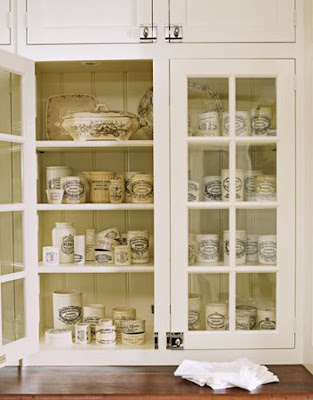Anyway, I find an often overlooked aspect of decorating is how we use lighting. This includes lamps and general light fixtures, but I'm talking more of accent lighting. I have a few favorites that are cheap and easy to install.
The first is dimmer switches. OH, they are a must! First of all, they save energy. I have never, in more than four years, had to change a light bulb in a fixture with a dimmer. But the best part of dimmers is the how you can change the mood of the room with the lighting. I hate bright lights, so I am in love with dimmers. And they are so, so, SO easy to install. You'll need to turn off the light at the fuse box. (VERY important!!!) Then unscrew the wall plate, remove the old switch, match the smooth wire to the smooth wire, the bumpy one to the bumpy wire, and screw in the ground wire. It is actually easier to do than it sounds. (I'm not lying -- try it!)
This is a typical dimmer switch:

You can get them at Lowes, Home Depot, etc. The most basic versions are what I use and are only $7 each! They get fancier and more expensive, but you really don't need the extras. I love them in the kitchen, the bedroom, and especially the master bathroom. A dimmer is a MUST on cold, winter mornings when it's still dark outside and you want to wake up slowly!
Another favorite lighting trick of mine is using rope lights. These can be used inside and out, and I because they're not particularly pretty, I suggest using them above cabinets and furniture or inside furniture. These are fun because they are flexible, easy to move to the shape you need and don't burn hot -- you can put them virtually anywhere. I use them above our kitchen cabinets and also tucked into the top of furniture. Plug them into an outlet that operates with a switch, and it makes them especially easy to use.
Rope lights come in a ton of colors, but for inside, I recommend clear or white:

They even come with little plastic hooks you can use to hold them into place. Rope lights come in a variety of lengths -- two feet, four feet, up to 20+ feet. The longer versions can get expensive, but the shorter lengths will run about $10 or less.
Finally, you can create mood lighting anywhere in your home with simple accent lights:

I have used them in corners, behind furniture, in potted plants (they make them specifically for plants). They are great for highlighting art, or just adding subtle mood lighting around your home. These tend to burn hotter than the others I've mentioned, so just be sure to check them and make sure they are not near anything that could catch fire. Accent lights like this one usually cost less than $10 each.
So run to Lowes, check some of these out and try them yourself! I dare you to install a dimmer and tell me it wasn't easy! (Just PLEASE make sure you turn off the switch at the fuse box!!) :)
 We received some tear sheets in the office the other day from a English company called Soane that I immediately thought must be somehow associated with Sir John Soane but turns out is not, though it might be possible they were inspired by him. Soane was actually founded by Lulu Lytle and Christopher Hodsoll in response to the demand for architecturally inspired bespoke furniture and lighting. "Our aim is to combine the superb design and workmanship of the most exciting antique pieces, with the highest quality British craftsmanship and the flexibility of furniture made to your specific requirements."
We received some tear sheets in the office the other day from a English company called Soane that I immediately thought must be somehow associated with Sir John Soane but turns out is not, though it might be possible they were inspired by him. Soane was actually founded by Lulu Lytle and Christopher Hodsoll in response to the demand for architecturally inspired bespoke furniture and lighting. "Our aim is to combine the superb design and workmanship of the most exciting antique pieces, with the highest quality British craftsmanship and the flexibility of furniture made to your specific requirements."










.jpg)




 John Rufenacht is not only a talented interior designer but is also the founder of Dining by Design. I think a lot of New Yorkers would be surprised to know that this wonderful event was begun in Kansas City more than fifteen years ago and has become the "signature event for DIFFA chapters nationwide." I very much enjoyed meeting Mr. Rufenacht and his partner, Richard Lara, who were both so lovely and gracious and I look forward to seeing what he does next!
John Rufenacht is not only a talented interior designer but is also the founder of Dining by Design. I think a lot of New Yorkers would be surprised to know that this wonderful event was begun in Kansas City more than fifteen years ago and has become the "signature event for DIFFA chapters nationwide." I very much enjoyed meeting Mr. Rufenacht and his partner, Richard Lara, who were both so lovely and gracious and I look forward to seeing what he does next!



















 They even come with little plastic hooks you can use to hold them into place. Rope lights come in a variety of lengths -- two feet, four feet, up to 20+ feet. The longer versions can get expensive, but the shorter lengths will run about $10 or less.
They even come with little plastic hooks you can use to hold them into place. Rope lights come in a variety of lengths -- two feet, four feet, up to 20+ feet. The longer versions can get expensive, but the shorter lengths will run about $10 or less.








